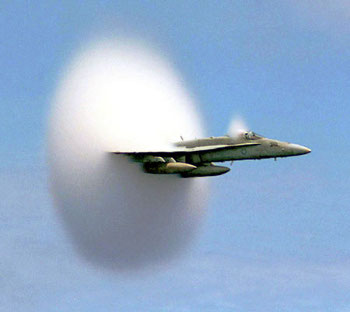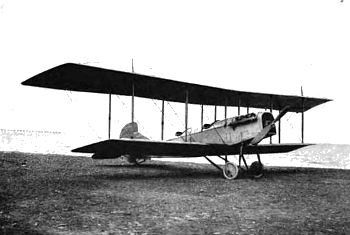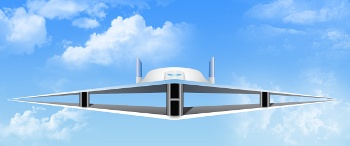Supersonic Biplane
March 30, 2012
Most people today have never heard a
sonic boom, the
shock wave-induced
sound caused by an object exceeding the
speed of sound. An
optical analog would be
Cherenkov radiation, the bluish glow seen in the
water coolant of
nuclear reactors that's caused when
beta radiation travels in the coolant faster than the
speed of light in that medium.
Supersonic aircraft will create sonic booms, although the sonic booms more likely to have been heard recently are from
Space Shuttle reentry and an occasional large
meteor.

Condensation caused by sonic boom pressure.
(Photo by U.S. Navy Ensign John Gay of the USS Constellation, via Wikimedia Commons))
In an earlier age, when air travel was still enjoyable and affordable, there was talk about routine
supersonic air travel. The only supersonic aircraft fleet seriously fielded was the
Concorde, which was prohibited from flying at supersonic speed over ground because of sonic boom. Flying at high
altitude somewhat attenuates the sonic boom at ground level, but it's always there. The Concorde's final flight was nearly a decade ago, on November 26, 2003, and there are presently no commercial supersonic aircraft.
Since sonic boom is a problem, there was considerable research devoted to its mitigation. One such mitigation involved a redesign of the
airframe.
Adolf Busemann, a prolific
aerospace engineer, invented an airframe shape called
Busemann's Biplane. As its name indicates, this was a
two-winged craft, as was the original
Wright brothers aircraft.

Curtiss Reconnaissance Biplane, 1918.
Curtiss merged with Wright Aeronautical in 1929 to form Curtiss-Wright
(Via Wikimedia Commons))
Busemann's design directed the supersonic airflow between the wings, as shown in the figure. The high pressure shock wave reflects from the angled surfaces and
destructively interferes with itself when it reaches the rear of the craft. The result is that the sonic boom is canceled before it exits the wing structure. The flow over the flat surfaces is parallel, so no shock wave is produced, but the design has a fundamental problem. The wing structure is
symmetrical, so there's no
lift at a forward flight angle, a fundamental problem when you're building an aircraft.

The principle of the Busemann Biplane. The shock wave destructively interferes with itself as it exits the space between the wings. The pressure profile is shown. (Based on a Wikipedia image, rendered by the author using Inkscape)
Along with the problem of not having lift, the Busemann Biplane has a
transition point as it reaches
supersonic speed that's nearly impossible to overcome. Air in the channel between the wings stops flowing, creating tremendous
drag. The biplane will fly at supersonic speed, but it can never reach those speeds.[1] One approach, under investigation by a
research team at
Tohoku University, led by
Professor Shigeru Obayashi, is designing a Busemann-like biplane with moving parts. The wings would change shape in order to attain supersonic speeds.[1]
Aeronautical engineers at the
Massachusetts Institute of Technology Department of Aeronautics and Astronautics and
Stanford University are investigating how the Busemann Biplane design might be improved.
Qiqi Wang, an
assistant professor in the department, along with his
post-doc, Rui Hu, and
Antony Jameson, a
professor at Stanford University, are using
computer modeling to solve the drag problem.
The computer model simulated the performance of Busemann's biplane at various speeds, so the drag could be computed for a wing shape. An optimal structure was then generated using performance data for 700 wing configurations at a dozen speeds.[1] The model has shown that a biplane can have less drag than a conventional single-wing aircraft, such as the Concorde, at supersonic cruise speeds.[1]

Conceptual drawing of a supersonic biplane. This MIT image is based on an original drawing courtesy of Obayashi laboratory, Tohoku University.
(Christine Daniloff/MIT))
Slightly smoothing the inner surface of each wing created a wider channel between the wings for airflow. Bumping out the top edge of the higher wing, and the bottom edge of the lower wing, allowed supersonic flight with half the drag of a Concorde. The sonic boom is not entirely eliminated, but the
fuel saving is considerable, and the fuel demand may actually be cut in half.[1] This would have a considerable benefit. Says Wang,
"If you think about it, when you take off, not only do you have to carry the passengers, but also the fuel, and if you can reduce the fuel burn, you can reduce how much fuel you need to carry, which in turn reduces the size of the structure you need to carry the fuel... It's kind of a chain reaction."[1]
The results of this study will be published in the
Journal of Aircraft.[1]
References:
- Jennifer Chu, "A biplane to break the sound barrier," MIT Press Release, March 15, 2012.
- Web site of Qiqi Wang's group at MIT.
Permanent Link to this article
Linked Keywords: Sonic boom; shock wave; sound; speed of sound; optics; Cherenkov radiation; nuclear reactor coolant; nuclear reactor; beta radiation; speed of light; supersonic aircraft; Space Shuttle; atmospheric entry; reentry; meteor; condensation; pressure; U.S. Navy Ensign John Gay; USS Constellation; Wikimedia Commons; supersonic air travel; Concorde; altitude; airframe; Adolf Busemann; aerospace engineer; Busemann's Biplane; two-winged craft; Wright brothers; Curtiss Aeroplane and Motor Company; Wright Aeronautical; Curtiss-Wright; destructive interference; symmetry; symmetrical; lift; Wikipedia; Inkscape; transition point; Mach number; supersonic speed; drag; research team; Tohoku University; Professor Shigeru Obayashi; Massachusetts Institute of Technology; Department of Aeronautics and Astronautics; Stanford University; Qiqi Wang; assistant professor; post-doc; Antony Jameson; professor; computer modeling; Christine Daniloff; aviation fuel; Journal of Aircraft.